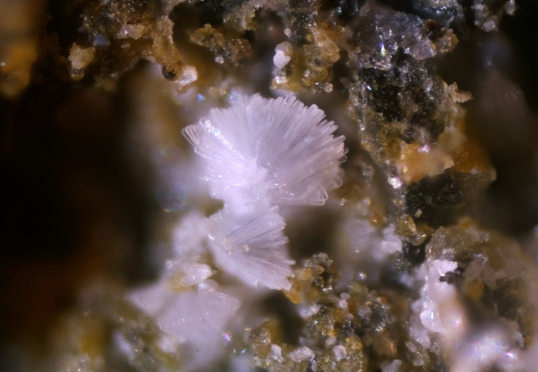
ABSTRACT
The new mineral afmite, Al3(OH)3(H2O)3(PO4)(PO3OH)·H2O, is triclinic with space group P1 and cell parameters a = 7.386(3), b = 7.716(3), c = 11.345(4) Å, α = 99.773(5), β = 91.141(6), γ = 115.58(5) V = 571.6(3) Å3 and Z = 2. It occurs, sometimes in association with matulaite and variscite, in fractures and solution cavities in shale/siltstone at Fumade, Tarn, France. The formation is probably largely the result of remobilisation and crystallisation during low-temperature hydrothermal activity and/or weathering and ground water activity. Afmite forms in cockscomb aggregates of diamond-shaped tablets on {001}, ubiquitously contact-twinned on {001} and also commonly twinned by rotation on [010] with {010} and {100} composition planes, forming star-like sixlings. The streak of the mineral is white, the luster is pearly, and the Mohs hardness is about 1½. The mineral is flexible, but not elastic, has an irregular fracture and three cleavage directions: {001} perfect, {010} and {1-10} good. The measured density is 2.39(3) g/cm3 and the calculated density is 2.391 g/cm3 based upon the empirical formula. Optical properties (white light): biaxial (+), α = 1.554(1), β = 1.558(1), γ = 1.566(1), 2Vmeas. = 70(5) and 2Vcalc = 71. Electron microprobe analyses provided Al2O3 40.20 and P2O5 38.84 wt% and CHN analyses provided H2O 25.64 wt%, total 103.68 wt%. Normalized EMP analyses and water based on the structure yield Al2O3 36.41, P2O5 35.17 and H2O 28.42, total 100.00 wt%. Infrared and Raman spectra were consistent with the PO3OH, OH and H2O as indicated by the crystal structure determination. The strongest powder X-ray diffraction lines are [dobs(Å),Iobs,(hkl)]: 11.089,(100,001), 3.540,81,(0-13,-1-12), 5.484,79,(002,101), 2.918,60(-122), 3.089,33(-113,201), 4.022,30,(102,-112), 6.826,23,(010). The crystal structure, solved from twinned data, (R1 = 10.4 % for 1262 Fo > 4σF reflections) consists of chains of AlO6 octahedra parallel to [110] in which edge-sharing octahedral dimers share corners with individual octahedra. Both PO4 and PO3OH tetrahedra link the chains into sheets parallel to {001} and the PO4 tetrahedra further serve to link two sheets together into a thick slab in which tetrahedral (T) and octahedral (O) layers alternate, forming a T-O-T-O-T sandwich. The linkage between these sandwiches in the c direction is via hydrogen bonding with isolated H2O groups in the interlayer region. Afmite is closely related structurally to the turquoise-group minerals and specifically to planerite. The recently described mineral kobokoboite probably has a closely related sheet structure.

0.4 mm wide aggregates of afmite crystals